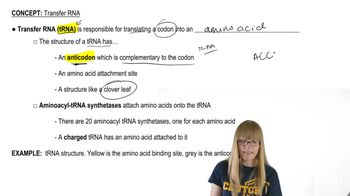What observations suggested the existence of mRNA?
Table of contents
- 1. Introduction to Genetics51m
- 2. Mendel's Laws of Inheritance3h 37m
- 3. Extensions to Mendelian Inheritance2h 41m
- 4. Genetic Mapping and Linkage2h 28m
- 5. Genetics of Bacteria and Viruses1h 21m
- 6. Chromosomal Variation1h 48m
- 7. DNA and Chromosome Structure56m
- 8. DNA Replication1h 10m
- 9. Mitosis and Meiosis1h 34m
- 10. Transcription1h 0m
- 11. Translation58m
- 12. Gene Regulation in Prokaryotes1h 19m
- 13. Gene Regulation in Eukaryotes44m
- 14. Genetic Control of Development44m
- 15. Genomes and Genomics1h 50m
- 16. Transposable Elements47m
- 17. Mutation, Repair, and Recombination1h 6m
- 18. Molecular Genetic Tools19m
- 19. Cancer Genetics29m
- 20. Quantitative Genetics1h 26m
- 21. Population Genetics50m
- 22. Evolutionary Genetics29m
10. Transcription
Overview of Transcription
Problem 39
Textbook Question
Answer the following questions about the accompanying diagram.
What is the name of the molecule closest to C? <>
 Verified step by step guidance
Verified step by step guidance1
Examine the accompanying diagram carefully to identify the molecule closest to point C. Look for any labels, structural features, or chemical groups that might help in identification.
Review the context of the diagram. If it is related to a specific biological process (e.g., DNA replication, transcription, or metabolic pathways), consider the types of molecules typically involved in that process.
Identify distinguishing features of the molecule near point C, such as its shape, size, or chemical composition. For example, if the molecule has a phosphate group, it might be part of a nucleotide.
Compare the molecule near point C to known examples of molecules in genetics, such as DNA, RNA, proteins, or metabolites. Use structural clues to narrow down the possibilities.
If the diagram includes additional annotations or labels, use them to confirm your identification of the molecule closest to point C.
 Verified video answer for a similar problem:
Verified video answer for a similar problem:This video solution was recommended by our tutors as helpful for the problem above
Video duration:
2mPlay a video:
Was this helpful?
Key Concepts
Here are the essential concepts you must grasp in order to answer the question correctly.
Molecular Structure
Understanding molecular structure is essential in genetics, as it refers to the arrangement of atoms within a molecule. This includes the types of atoms present, their connectivity, and the three-dimensional shape of the molecule. In the context of the question, identifying the molecule closest to point C requires knowledge of how to interpret diagrams that depict molecular structures.
Recommended video:
Guided course

Ribosome Structure
Nucleic Acids
Nucleic acids, such as DNA and RNA, are fundamental molecules in genetics that store and transmit genetic information. They are composed of nucleotide units, which include a sugar, a phosphate group, and a nitrogenous base. Recognizing the specific nucleic acid depicted in the diagram is crucial for answering the question about the molecule near point C.
Recommended video:
Diagram Interpretation
Diagram interpretation involves analyzing visual representations of biological structures to extract meaningful information. This skill is vital in genetics, where diagrams often illustrate complex concepts like molecular interactions or genetic pathways. Being able to accurately read and interpret the diagram in the question will help identify the molecule closest to point C.
Recommended video:
Guided course

Branch Diagram

 6:32m
6:32mWatch next
Master Overview of Transcription with a bite sized video explanation from Kylia
Start learningRelated Videos
Related Practice
Textbook Question
552
views

